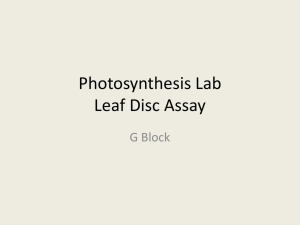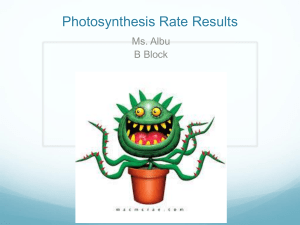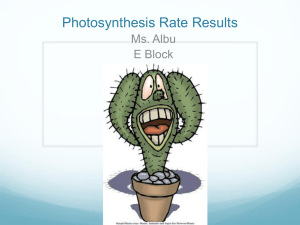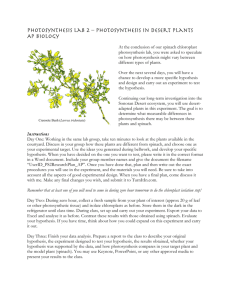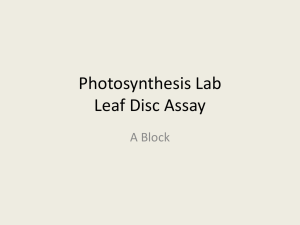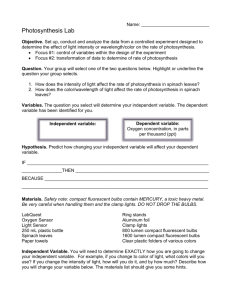Class Results B
advertisement
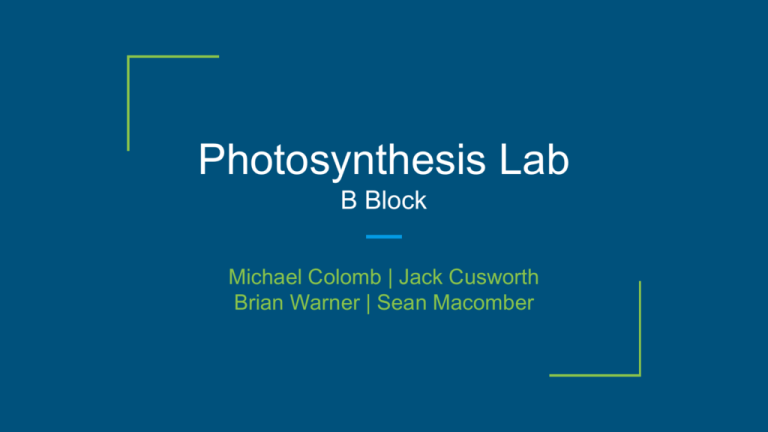
Photosynthesis Lab B Block Michael Colomb | Jack Cusworth Brian Warner | Sean Macomber Background 6 CO2 + 6 H2O → C6H12O6 + 6 O2 Spinach Leaves Deep Green color Flatter leaves Slightly wilted Large amounts of chlorophyll a, chlorophyll b, and beta-carotene Kale Leaves Darker Green Large amounts of lutein and betacarotene Curling leaves Results Photosynthetic Rate of Kale: 0.025 floats per second Photosynthetic Rate of Spinach: 0.033 floats per second Conclusion ● We observed that the spinach leaf chads had a higher photosynthetic rate than the kale leaf chads due to the fact that the spinach chads all surfaced in a smaller amount of time than the kale chads. ● This difference in photosynthetic rate between the two types of leaves occurred because of the larger amounts of chlorophyll A and B in spinach which allowed for more photosynthesis, thus increasing the rate. ● The leaf chads all rose to the top of the beaker due to the release of O2 gas, as a byproduct of photosynthesis, and replaced the water that was in the chads in the beginning of the experiment. Conclusion contd. One way to improve this lab would be to repeat the lab multiple times to account for error and provide more consistent and accurate data. Another way to increase the effectiveness of this lab would be to make sure both sets of leaf chads are placed in the bicarbonate solution for a consistent amount of time before the tin foil is removed from the top of the beaker and the timer starts. Works Cited and Acknowledgements Works Cited Isolation of Chlorophyll and Carotenoid Pigments from Spinach. Los Angeles: UCLA, n.d. PDF. Lefsrud, Mark, Dean Kopsell, Adam Wenzel, and Joseph Sheehan. "Changes in Kale (Brassica Oleracea L. Var. Acephala) Carotenoid and Chlorophyll Pigment Concentrations during Leaf Ontogeny." Scientia Horticulturae 112.2 (2007): 136-41. ScienceDirect. Web. 19 Oct. 2015. Thanks to the one and only Ms. Albu for the Spinach and Kale leaves and to Seany Mac and Cheese for the Oak leaves! Photosynthesis Lab Julia Devlin, Sakshi Jhawar, Tiffany Lu, Julie Woodward B Block Background BABY SPINACH: Grown in slight or NO shade areas Very few veins Rich, vibrant green leaves Mostly chlorophyll; also lutein (yellow) and a bit of carotene (orange) Soft, juicy leaves-- very penetrable epidermis Known for its fast photosynthetic rate BABY KALE: Grown in cool, damp places; prefers less light Many veins Different shade of green-less rich Baby kale harvested after 1-2 weeks: Lutein, 2 types of Carotene, Xanthophylls at peak Low levels of chlorophyll at this time: increases & maxes @ ~3wks Thick, tougher leaves-- harder epidermis for coldresistance? Results *Note: Our data collection method was very different- we found the total time for all the chads to float and divided it by the number of chads that floated to get the average floats/ second, seconds/ float, ect. BABY SPINACH: Time for ALL floats: 4 min 16.34 sec (256.34 sec) Floats/second= 0.039 seconds per float= 25.64 BABY KALE: Time for ALL floats: 5 min 12.13 sec (312.13 sec) Floats/second= 0.032 seconds per float= 31.25 Average Reaction Rate Comparison Average Second/Float Comparison Conclusions The leaf type with the faster photosynthetic rate was the baby spinach. This disproved our original hypothesis. In baby spinach the pigment with the highest concentration was chlorophyll In baby kale the pigments with the highest concentrations were lutein, carotene, and xanthophylls Because chlorophyll is the chemical responsible for photosynthesis the plant with more of it would have a higher rate of photosynthesis. Kale is used to growing in environments with little light, so it is unadapted to highly evaporative environments such as the intensely lit set up in this experiment. On the other hand, spinach is adapted to this sort of lighting Conclusion (cont.) Our data cannot be compared with the other groups data as we only used 10 leaf chads as opposed to 20. We also did not measure the number of floats per minute for 10 minutes. Instead we measured the total time it took for all of the leaf chads to float to the top, and therefore our rate was derived differently. If we were to do this experiment again we would use 20 leaf chads instead of 10 and measure the amount of floats in the proper intervals instead of just the total amount of time to ensure that we have results that are comparable to the rest of the groups. Works Cited Spinach Information: http://www.mdidea.com/products/proper/proper03103.html http://christopherking.name/Organic%20I%20Labs/Plant%20pigments%20by%20TLC_files/image013.gif http://socrates8181nc.tripod.com/id10.html Kale Information: https://en.wikipedia.org/wiki/Kale http://www.sciencedirect.com/science/article/pii/S0304423806005140 http://gentleworld.org/kale-an-easy-beginners-guide-to-growing/#Finding the right spot and time to plant Leaf Structure and Conclusions Research: http://w3.marietta.edu/~biol/introlab/Leaves%20and%20Pigments.pdf https://en.wikipedia.org/wiki/Leaf#Venation_2 http://www.enchantedlearning.com/subjects/plants/leaf/ http://www.botgard.ucla.edu/html/botanytextbooks/generalbotany/shootfeatures/generalstructure/leafcolor/xanthophylls.html Thanks to Sakshi for the kale! Photosynthesis Lab: Leaf Disc Assays Basil vs. Spinach! Naqiya M., Trisha K., Esther K., Priya I., Andee S. B - AP Biology Introduction/Background ❏ Lighter green color would reflect more and absorb less light than darker green color due to lower chlorophyll amounts (and vice versa) SPINACH ❏ ↓ green pigment = ↓ chlorophyll amount = ↓ light absorption = ↓ photosynthesis rate = ↑ time for the leaf chads to float to the top ❏ Leaf chads float because of oxygen gas produced, and oxygen can be produced both in and out of the bicarbonate solution ❏ Basil leaves are lighter than spinach leaves, suggesting lesser chlorophyll amounts and lower photosynthesis rate ❏ Predicted that basil leaf chads would have a lower rate (chads floating/second) than spinach leaf chads BASIL Result s This graph shows the number of spinach and basil leaf chads that were floating over time. Average rate for spinach: -> 18 chads/ 600 seconds = .03 floats/second --- 3% of discs Average rate for basil: -> 13 chads/ 600 seconds = .02166 floats/second ---~2% of discs Conclusion The spinach leaves rose quickly to the top after a few minutes more chlorophyll allows for more light to enter the chad, so more electrons are going through the electron transport chain causing a faster reaction in phosphorylation – Observation: The spinach took less time to float to the surface than it did for the basil Progression of spinach leaf chads floating to surface Continued – Reasoning: The darker pigment of spinach = more chlorophyll = more light is able to come in and excite photosynthesis than it can for the basil – Redesign/Extension: More trials To ensure the accuracy of our results More types of leaves Expanding hypothesis rationale Manipulating different variables in addition to the type of leaf used Ex. Amounts of light received Motiwalla, Kagalavadi, Kim, Iyengar, Song Works Cited B., Michael. "Basil." Evoo Marketplace. Evoo Marketplace, 2015. Web. 18 Oct. 2015. Brother, B. "Happy Spinach Vegetable Cartoon." Zazzle. Zazzle, 2015. Web. 18 Oct. 2015. Busch, Sandi. "What Kind of Food Contains a High Amount of Chlorophyll?" SF Gate. Demand Media, 2015. Web. 18 Oct. 2015. Oven, G. S. "Fresh Spinach." Tablespoon. General Mills, 25 Feb. 2013. Web. 18 Oct. 2015. Slavid, Lisa. "Basil." Peadoodles. Peadoodles, 4 Aug. 2009. Web. 18 Oct. 2015. Acknowledgements Thanks to Esther Kim for the basil leaves! And Ms. Albu for the spinach leaves of course 😊 Also, Naqiya says “hi” from Houston and really misses her leaf chads! Photosynthesis Lab: Leaf Disc Assay Ali Kea, Brianna Kenney, Victoria Loosigian, Ally Rohlfs B Block Background - Spinach is a C3 plant - 25 species within the Mint genus - Our experiment used spearmint, which is a C3 plant - Spinach is a darker shade of green than the mint - Pigment affects the rate of photosynthesis - Our hypothesis was that mint leaves would have a faster photosynthetic rate because it has a lighter pigment Spinach Spearmint Results C0nclusion - We found that spinach leaves floated at a greater rate than the mint leaves - This proved our hypothesis wrong - Overall Photosynthetic Rate - Spinach: 0.0458 floats per second - Mint: 0.0133 floats per second - Spinach and mint have different photosynthetic rates because they have different amounts of pigments and have differently adapted stomata - The Spinach had a faster reaction rate so it most likely had more light absorbing pigments or their stomata which let in carbon dioxide faster - Extension/Redesign - All of the spinach leaf chads floated before four minutes so we were unable to compare the mint and spinach photosynthetic rates after four minutes. - If repeating this experiment, we would complete more trials and add more leaf chads to each beaker Works Cited Picture URLs: http://www.organic-sourcing.com/spearmint.jpg http://awaytogarden.com/wp-content/uploads/2010/09/semi-savoy-spinach.jpg Citations: "Mint." Encyclopaedia Britannica. Enyclopaedia Britannica, 2015. Web. 18 Oct. 2015. - Acknowledgments: thank you to Victoria and her mom’s herb garden for providing us with the mint leaves Lettuce Vs. Spinach, The Chad Race David Gillett, Mark Dunne, Neehath Malisetty B: Block Spinach Dark green leafy vegetable, that goes through photosynthesis Spinach contains the chlorophyll a and chlorophyll b pigments There are 14 photosynthetic chlorophyll pigments in each monomer with 8 chlorophyll a and 6 chlorophyll b Both of these chlorophylls are very effective photoreceptors because they contain a network of alternating single and double bonds Romaine Lettuce Light colored green leafy vegetable with a thick spine Low level of chlorophyll in the leaf High chlorophyll a and b ratios Depleted in components of the light-harvesting chlorophyllprotein complex Video of the Lettuce Chads Results Conclusion O2 bubbles surrounded the leaf chads causing them to float Spinach photosynthetic rate was slightly higher Spinach = Higher photosynthetic rate because Spinach = Darker/More chlorophyll Extension: Explore other factors that affect photosynthetic rate distance of lamp from the beaker light color temperature concentration of CO2 Works cited & acknowledgements Thanks to the Dunn family for providing the lettuce Thanks to Ms. Albu for the spinach
